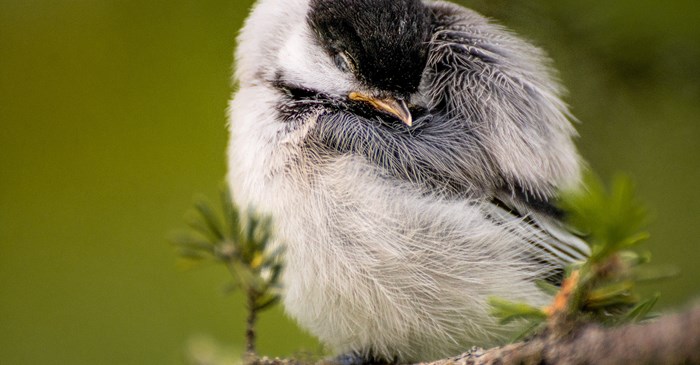Birds can brighten our winter days with their appearances at our feeding stations. Admittedly, it gives you a warm feeling knowing you’re doing your part. However, when the sun sets, you look out onto the frigid landscape and find it difficult to imagine where birds sleep on winter nights.
Here’s what they do.
Where do birds sleep in the winter?
If you have any evergreen shrubs or trees in your landscaping, there’s probably a bird or two tucked under the branches. Huddling under the shelter of the branches keeps them out of the cold wind and hidden from nighttime predators. If you let the nesting box stay out for the winter, they may use it for winter cover.
Finding shelter is just one part of a songbird’s wintertime stay-warm-at-night strategy. Birds layer many other tactics to help them get through the night.
Birds puff their feathers for warmth
That slick-looking layer of plumage is layered with different types of feathers. Some are made for flight, but the innermost feathers, the down feathers, insulate the bird.
They’ll puff their plumage to activate these down feathers, which trap the warm air close to their body. (A bird that looks “fat” is actually wearing their little winter parka!)
They huddle and roost
In the spring, birds form intense rivalries for mates and territories. In the winter, however, birds recognize the benefit of safety in numbers. They’ll form foraging alliances, but they’ll also huddle at night to construct a blockade of warmth and protection. They might gather in trees, sitting in a close row. Some songbirds will pack themselves into a tree cavity or nesting box.
Birds shiver to create body heat
It’s not just you: Birds shiver too. Birds have a much faster metabolic rate than humans, which means they burn more energy to stay warm than we do. Shivering helps birds create body heat when they’re cold.
Some birds enter a state of torpor
When the nights are long and the temperatures plummet, songbirds need extra energy to stay warm through the night. This creates a dilemma.
- Option A is to venture out for food, but risk getting caught by a predator.
- Option B is to stay put and hope to survive until morning.
Scientists have learned that the small but mighty Black-capped Chickadee has solved this by entering a state of torpor on cold nights. One way to think of it is that the bird goes into energy-saving mode because they lower their body temperature and shiver to generate body heat. Because they need fewer calories to maintain their core temperature, they can get through a chilly night.
They forage for resources
Birds are always on the lookout for a new source of food, especially when the offerings from the landscape become scarce. Through the winter, keep your feeders filled and watch and wait for your friendly neighborhood birds to stop in for a snack.
Lyric Chickadee Premium Sunflower & Nut Mix is made with a 100% sunflower seed and nut blend that attracts chickadees, woodpeckers, and other bird friends that stay for the winter.
